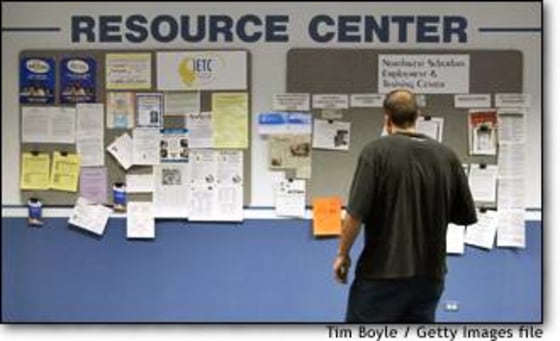The nation’s jobless rate rose to a nine-year high of 6.1 percent last month as employers cut another 17,000 jobs from an economy muddling its way through a barely perceptible recovery.
The unemployment rate, which rose from 6 percent in April, hit a level not seen since the nation was emerging from its last recession in the early 1990s, the Labor Department said Friday.
The report was roughly in line with market expectations, but stock prices rose, extending a three-month rally that has been built at least in part on the view that better times are ahead for the sluggish economy.
Few analysts expect job growth to be a significant part of that picture in the near future, noting that employment typically lags overall economic growth, and businesses are particularly cautious after a long bear market, a wave of corporate scandals and geopolitical upheaval.
“We still have a jobless economic recovery — the trend has not changed,” said Sung Won Sohn, chief economist for Wells Fargo. “There doesn’t seem to be any conviction that the recovery is here to stay.”
He pointed out that employers boosted the number of temporary workers in May, reflecting a hesitancy to add permanent positions.
The Bureau of Labor Statistics published a major revision of employment figures along with the May report, resulting in a significant improvement in results for the past several months. But the economy still has lost 2.5 million jobs since February 2001 and 342,000 over the past six months, a period when the nation’s gross domestic product has been growing, although at a relatively slow rate of less than 2 percent.
“At this stage of economic recovery we should be seeing closer to 6 percent growth, not 2 or 3 percent,” Sohn said. “And when it comes to employment, clearly there are no gains at all. We’re still losing jobs on balance.”
Economists are divided on whether the latest employment news is dismal enough to spur another reduction in short-term interest rates when Federal Reserve policy-makers next meet June 24 and 25.
“Broadly speaking, the labor market remains weak, although upward revisions to the most recent history make the 2003 performance look not as awful as previously reported.” said Credit Suisse First Boston economist Jay Feldman in a note. But he said that given recent comments by Fed Chairman Alan Greenspan, who has indicated that the central bank is increasingly concerned about the possibility of deflation, a quarter-point cut is likely for the benchmark federal funds rate, now at a 40-year record low of 1.25 percent.
One reason for last month’s increase in unemployment was that more people resumed their job searches, but failed to find work. Nearly 9 million people were unemployed in May.
“We’ve got a long way to go,” said Ken Mayland, president of ClearView Economics. “But as they say, the longest journey begins with a first step. It looks like we’ve taken that first step.”
Manufacturing, transportation and government were among the sectors losing the most jobs.
Still, some sectors were hiring in May. Employment rose in construction and in service jobs, including education and health services.
But even if the economy improves later this year, as economists hope, the jobless rate still is expected to climb as high as 6.5 percent.
Job growth probably won’t be strong enough to accommodate all the additional job seekers who would resume their searches, attracted by an improved climate. That would contribute to a rise in the unemployment rate, which happened last month.
The sluggish job market so far hasn’t caused consumers to shut their pocketbooks and wallets. They are the main force keeping the economy going, but they are being more selective.
Low interest rates have fueled a mortgage refinancing boom that has given people extra cash and solid home values. Those low rates also have generated continuous hiring in the construction industry.
May’s report showed that the average time for people to be out of work was 19.2 weeks. People out of work 27 weeks or longer grew slightly by 300,000 to 1.9 million.
The Associated Press contributed to this report.
